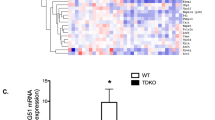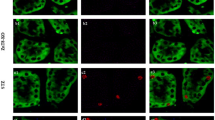Abstract
Proteinuria may contribute to progressive renal damage by inducing tubulointerstitial inflammation, fibrosis and tubular cell apoptosis, but the underlying mechanisms remain largely unknown. TRB3 is a kinase-like molecule that can modify cellular survival and interfere with signal transduction pathways. We seek to determine the role of TRB3 in renal tubular cell apoptosis associated with proteinuria. Herein, we reported that in a rat tubular cell line, high concentration of albumin augmented TRB3 expression and induced apoptosis, while TRB3 silencing with special small interference RNA significantly attenuated apoptosis. In addition, we found that albumin-induced apoptosis was related to inhibition of Akt phosphorylation, which was, however, partially reversed by TRB3 silencing, indicating that TRB3 worked through Akt pathway in this apoptotic signaling cascade. In vivo, we observed increased TRB3 expression in kidneys of streptozotocin-induced diabetic nephropathy model and albumin-overload nephropathy model, both of which showed overt proteinuria. Notably, proteinuria induced apoptosis in renal tubules, which was less severe after genetically inhibition of TRB3. Taken together, these results suggest that TRB3 mediates renal tubular cell apoptosis induced by protein overload, broadening our understanding of the pathogenesis of progressive proteinuric kidney diseases.





Similar content being viewed by others
References
Ruggenenti P, Remuzzi G (2000) The role of protein traffic in the progression of renal diseases. Annu Rev Med 51:315–327. doi:10.1146/annurev.med.51.1.315
Brunskill NJ (1998) Molecular interactions between albumin and proximal tubular cells. Exp Nephrol 6(6):491–495
Erkan E (2013) Proteinuria and progression of glomerular diseases. Pediatr Nephrol 28(7):1049–1058. doi:10.1007/s00467-012-2335-1
Hegedus Z, Czibula A, Kiss-Toth E (2006) Tribbles: novel regulators of cell function; evolutionary aspects. Cell Mol Life Sci 63(14):1632–1641. doi:10.1007/s00018-006-6007-9
Boudeau J, Miranda-Saavedra D, Barton GJ, Alessi DR (2006) Emerging roles of pseudokinases. Trends Cell Biol 16(9):443–452. doi:10.1016/j.tcb.2006.07.003
Hegedus Z, Czibula A, Kiss-Toth E (2007) Tribbles: a family of kinase-like proteins with potent signalling regulatory function. Cell Signal 19(2):238–250. doi:10.1016/j.cellsig.2006.06.010
Schwarzer R, Dames S, Tondera D, Klippel A, Kaufmann J (2006) TRB3 is a PI 3-kinase dependent indicator for nutrient starvation. Cell Signal 18(6):899–909. doi:10.1016/j.cellsig.2005.08.002
Ord D, Ord T (2005) Characterization of human NIPK (TRB3, SKIP3) gene activation in stressful conditions. Biochem Biophys Res Commun 330(1):210–218. doi:10.1016/j.bbrc.2005.02.149
Bowers AJ, Scully S, Boylan JF (2003) SKIP3, a novel Drosophila tribbles ortholog, is overexpressed in human tumors and is regulated by hypoxia. Oncogene 22(18):2823–2835. doi:10.1038/sj.onc.1206367
Corcoran CA, Luo X, He Q, Jiang C, Huang Y, Sheikh MS (2005) Genotoxic and endoplasmic reticulum stresses differentially regulate TRB3 expression. Cancer Biol Ther 4(10):1063–1067
Du K, Herzig S, Kulkarni RN, Montminy M (2003) TRB3: a tribbles homolog that inhibits Akt/PKB activation by insulin in liver. Science 300(5625):1574–1577. doi:10.1126/science.1079817
Cusimano A, Azzolina A, Iovanna JL, Bachvarov D, McCubrey JA, D’Alessandro N, Montalto G, Cervello M (2010) Novel combination of celecoxib and proteasome inhibitor MG132 provides synergistic antiproliferative and proapoptotic effects in human liver tumor cells. Cell Cycle 9(7):1399–1410
Ohse T, Inagi R, Tanaka T, Ota T, Miyata T, Kojima I, Ingelfinger JR, Ogawa S, Fujita T, Nangaku M (2006) Albumin induces endoplasmic reticulum stress and apoptosis in renal proximal tubular cells. Kidney Int 70(8):1447–1455. doi:10.1038/sj.ki.5001704
Lindenmeyer MT, Rastaldi MP, Ikehata M, Neusser MA, Kretzler M, Cohen CD, Schlondorff D (2008) Proteinuria and hyperglycemia induce endoplasmic reticulum stress. J Am Soc Nephrol 19(11):2225–2236. doi:10.1681/ASN.2007121313
Zou T, Liu WJ, Li SD, Zhou W, Yang JF, Zou CG (2011) TRB3 mediates homocysteine-induced inhibition of endothelial cell proliferation. J Cell Physiol 226(11):2782–2789. doi:10.1002/jcp.22554
Datta SR, Brunet A, Greenberg ME (1999) Cellular survival: a play in three Akts. Genes Dev 13(22):2905–2927
Franke TF, Kaplan DR, Cantley LC (1997) PI3K: downstream AKTion blocks apoptosis. Cell 88(4):435–437
Khwaja A (1999) Akt is more than just a Bad kinase. Nature 401(6748):33–34. doi:10.1038/43354
Caruso-Neves C, Pinheiro AA, Cai H, Souza-Menezes J, Guggino WB (2006) PKB and megalin determine the survival or death of renal proximal tubule cells. Proc Natl Acad Sci USA 103(49):18810–18815. doi:10.1073/pnas.0605029103
Cravero JD, Carlson CS, Im HJ, Yammani RR, Long D, Loeser RF (2009) Increased expression of the Akt/PKB inhibitor TRB3 in osteoarthritic chondrocytes inhibits insulin-like growth factor 1-mediated cell survival and proteoglycan synthesis. Arthritis Rheum 60(2):492–500. doi:10.1002/art.24225
He L, Simmen FA, Mehendale HM, Ronis MJ, Badger TM (2006) Chronic ethanol intake impairs insulin signaling in rats by disrupting Akt association with the cell membrane. Role of TRB3 in inhibition of Akt/protein kinase B activation. J Biol Chem 281(16):11126–11134. doi:10.1074/jbc.M510724200
Li X, Pabla N, Wei Q, Dong G, Messing RO, Wang CY, Dong Z (2010) PKC-delta promotes renal tubular cell apoptosis associated with proteinuria. J Am Soc Nephrol 21(7):1115–1124. doi:10.1681/ASN.2009070760
Ohoka N, Yoshii S, Hattori T, Onozaki K, Hayashi H (2005) TRB3, a novel ER stress-inducible gene, is induced via ATF4-CHOP pathway and is involved in cell death. EMBO J 24(6):1243–1255. doi:10.1038/sj.emboj.7600596
Humphrey RK, Newcomb CJ, Yu SM, Hao E, Yu D, Krajewski S, Du K, Jhala US (2010) Mixed lineage kinase-3 stabilizes and functionally cooperates with TRIBBLES-3 to compromise mitochondrial integrity in cytokine-induced death of pancreatic beta cells. J Biol Chem 285(29):22426–22436. doi:10.1074/jbc.M110.123786
Shang YY, Wang ZH, Zhang LP, Zhong M, Zhang Y, Deng JT, Zhang W (2009) TRB3, upregulated by ox-LDL, mediates human monocyte-derived macrophage apoptosis. FEBS J 276(10):2752–2761. doi:10.1111/j.1742-4658.2009.06998.x
Ord D, Meerits K, Ord T (2007) TRB3 protects cells against the growth inhibitory and cytotoxic effect of ATF4. Exp Cell Res 313(16):3556–3567. doi:10.1016/j.yexcr.2007.07.017
Zhou H, Luo Y, Chen JH, Hu J, Luo YZ, Wang W, Zeng Y, Xiao L (2013) Knockdown of TRB3 induces apoptosis in human lung adenocarcinoma cells through regulation of Notch 1 expression. Mol Med Rep 8(1):47–52. doi:10.3892/mmr.2013.1453
Tadokoro D, Takahama S, Shimizu K, Hayashi S, Endo Y, Sawasaki T (2010) Characterization of a caspase-3-substrate kinome using an N- and C-terminally tagged protein kinase library produced by a cell-free system. Cell Death Dis 1:e89. doi:10.1038/cddis.2010.65
Shimizu K, Takahama S, Endo Y, Sawasaki T (2012) Stress-inducible caspase substrate TRB3 promotes nuclear translocation of procaspase-3. PLoS One 7(8):e42721. doi:10.1371/journal.pone.0042721
Datta SR, Dudek H, Tao X, Masters S, Fu H, Gotoh Y, Greenberg ME (1997) Akt phosphorylation of BAD couples survival signals to the cell-intrinsic death machinery. Cell 91(2):231–241
Gardai SJ, Hildeman DA, Frankel SK, Whitlock BB, Frasch SC, Borregaard N, Marrack P, Bratton DL, Henson PM (2004) Phosphorylation of Bax Ser184 by Akt regulates its activity and apoptosis in neutrophils. J Biol Chem 279(20):21085–21095. doi:10.1074/jbc.M400063200
Yamaguchi H, Wang HG (2001) The protein kinase PKB/Akt regulates cell survival and apoptosis by inhibiting Bax conformational change. Oncogene 20(53):7779–7786. doi:10.1038/sj.onc.1204984
Takase O, Minto AW, Puri TS, Cunningham PN, Jacob A, Hayashi M, Quigg RJ (2008) Inhibition of NF-kappaB-dependent Bcl-xL expression by clusterin promotes albumin-induced tubular cell apoptosis. Kidney Int 73(5):567–577. doi:10.1038/sj.ki.5002563
Meng F, Liu L, Chin PC, D’Mello SR (2002) Akt is a downstream target of NF-kappa B. J Biol Chem 277(33):29674–29680. doi:10.1074/jbc.M112464200
Sun ZJ, Chen G, Hu X, Zhang W, Liu Y, Zhu LX, Zhou Q, Zhao YF (2010) Activation of PI3K/Akt/IKK-alpha/NF-kappaB signaling pathway is required for the apoptosis-evasion in human salivary adenoid cystic carcinoma: its inhibition by quercetin. Apoptosis Int J Program Cell Death 15(7):850–863. doi:10.1007/s10495-010-0497-5
Erkan E, Devarajan P, Schwartz GJ (2007) Mitochondria are the major targets in albumin-induced apoptosis in proximal tubule cells. J Am Soc Nephrol 18(4):1199–1208. doi:10.1681/ASN.2006040407
Acknowledgments
This study was supported by Research Fund for the Doctoral Program of Higher Education of China (No. 20090131110026) and Science and Technology Development Program of Shandong Province (No. 2013GSF12104).
Conflict of interest
The authors declare that they have no conflict of interest.
Author information
Authors and Affiliations
Corresponding authors
Additional information
Guangju Guan and Gang Liu have contributed equally to this article.
Rights and permissions
About this article
Cite this article
Wang, W., Cheng, J., Sun, A. et al. TRB3 mediates renal tubular cell apoptosis associated with proteinuria. Clin Exp Med 15, 167–177 (2015). https://doi.org/10.1007/s10238-014-0287-4
Received:
Accepted:
Published:
Issue Date:
DOI: https://doi.org/10.1007/s10238-014-0287-4




